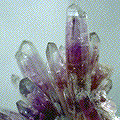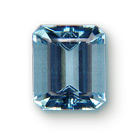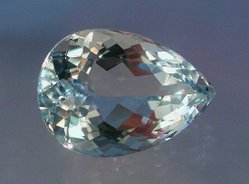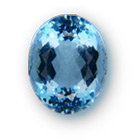The February Stone... Amethyst

The birthstone of February, amethyst's importance originates in antiquity. In the Bible, an amethyst is worn on the breastplate of Aaron, the high priest of the Hebrews. This amethyst represented the prophet Math, who was filled with the desire to please God and who had the gift of tongues. In folklore and mythology, amethyst has many supernatural powers. Amethyst purportedly Brings luck Ensures constancy Protects against magic Prevents home-sickness

Protects against drunkenness (the Greek word
amethustos means "not drunk") In Greek mythology, Dionysus, the god of wine and song, was angry and vowed to slay the first mortal who crossed his path. That unlucky mortal was Amethyst, a beautiful maiden. However, Artemis (goddess of virginity and the hunt) intervened and transformed Amethyst into white stone. When Dionysus saw what had happened, he repented and poured wine over the stone, staining the top of it purple. That is why the top of amethyst is purple and the bottom is white. Whether or not the avowed supernatural powers of amethyst holds any weight with you, amethyst is a gorgeous stone. The most valuable stone in the quartz family, its color ranges from pale red-violet to dark purple. It looks especially beautiful when set in gold and accented by diamonds.
Gemstone.org
Amethyst: a Royal PurplePurple has long been considered a royal color so it is not surprising that amethyst has been so much in demand during history. Fine amethysts are featured in the British Crown Jewels and were also a favorite of Catherine the Great and Egyptian royalty. Amethyst, transparent purple quartz, is the most important quartz variety used in jewelry.Leonardo Da Vinci wrote that amethyst was able to dissipate evil thoughts and quicken the intelligence.Because amethyst was thought to encourage celibacy and symbolize piety, amethyst was very

important in the ornamentation of Catholic and other churches in the Middle Ages. It was, in particular, considered to be the stone of bishops and they still often wear amethyst rings.In Tibet, amethyst is considered to be sacred to Buddha and rosaries are often fashioned from it.The Greek work "amethystos" basically can be translated as "not drunken." Amethyst was considered to be a strong antidote against drunkenness, which is why wine goblets were often carved from it! The gemstone still symbolizes sobriety.The legend of the origin of amethyst comes from Greek myths. Dionysius, the god of intoxication, was angered one day by an insult from a mere mortal and swore revenge on the next mortal that crossed his path, creating fierce tigers to carry out his wish. Along came unsuspecting Amethyst, a beautiful young maiden on her way to pay tribute to the goddess Diana. Diana turned Amethyst into a stature of pure crystalline quartz to protect her from the brutal claws. Dionysus wept tears of wine in remorse for his action at the sight of the beautiful statue. The god's tears stained the quartz purple, creating the gem we know today.Amethyst ranges in color from pale lilac to deep purple. The pale colors are sometimes called "Rose de France" and can be seen set in Victorian jewelry. The deep colors are the most valuable, particularly a rich purple with rose flashes.Amethyst is mined in Brazil, Uruguay, Bolivia and Argentina, as well as in Zambia, Namibia and other African countries.Generally, amethyst from South America tends to be available in larger sizes than African amethyst but amethyst from Africa has the reputation for having better, more saturated, color in small sizes. Very dark amethyst, mostly in small sizes, is also mined in Australia.Amethyst is available in a wide range of calibrated sizes and shapes, including many fancy shapes. Large fine stones may be sold in free sizes but generally amethyst is cut in standardized dimensions.
Amethyst is a violet or purple variety of quartz often used as an ornament. The name is generally said to be derived from the Greek
a, "not," and
methuskein, "to intoxicate," expressing the old belief that the stone protected its owner from drunkenness. It was held that wine drunk out of a cup of amethyst would not intoxicate. However, the word may probably be a corruption of an Oriental name for the stone.
A bed of amethyst crystals on base rock, 13cm (5in) long
In the 20th century, the color of amethyst was attributed to the presence of manganese. However, since it is capable of being greatly altered and even discharged by heat, the color was believed by some authorities to be from an organic source. Ferric thiocyanate was suggested, and sulfur was said to have been detected in the mineral. As of 2005, impurity atoms are known to be responsible of the colour of the amethyst.
On exposure to heat, amethyst generally becomes yellow, and much of the citrine, cairngorm, or yellow quartz of jewelry is said to be merely "burnt amethyst". Veins of amethystine quartz are apt to lose their color on the exposed outcrop.
Amethyst is composed of an irregular superposition of alternate lamellae of right-handed and left-handed quartz. It has been shown that this structure may be due to mechanical stresses. As a consequence of this composite formation, amethyst is apt to break with a rippled fracture, or to show "thumb markings", and the intersection of two sets of curved ripples may produce on the fractured surface a pattern something like that of "engine turning." Some mineralogists, following Sir David Brewster, apply the name of amethyst to all quartz which exhibits this structure, regardless of color.
Exhibition of in the Amethyst was used as a gemstone by the ancient Egyptians and was largely employed in antiquity for intaglios. Beads of amethyst are found in Anglo-Saxon graves in England. It is a widely distributed mineral, but fine, clear specimens that are suitable for cutting as ornamental stones are confined to comparatively few localities. Such crystals occur either in the cavities of mineral-veins and in granitic rocks, or as a lining in agate geodes. A huge geode, or "amethyst-grotto", from near Santa Cruz in southern Brazil was exhibited at the Düsseldorf1902. Many of the hollow agates of Brazil and Uruguay contain a crop of amethyst crystals in the interior. Much fine amethyst comes from Russia, especially from near MursinkaEkaterinburg district, where it occurs in drusy cavities in granitic rocks. Many localities in India yield amethyst; and it is found also in Sri Lanka, chiefly as pebbles.
6 Carat Pear Shape Amethyst Ring
Due to its popularity as a gemstone, several descriptive terms have been coined in the gem trade to describe the varying colors of amethyst. "Rose de France" is usually a pale pinkish lavender or lilac shade (usually the least sought color). The most prized color is an intense violet with red flashes and is called "Siberian", although gems of this color may occur from several locations other than Siberia, notably Uruguay and Zambia. In more recent times, certain gems (usually of Bolivian origin) have shown alternate bands of amethyst purple with citrine orange have been given the name ametrine.
Purple corundum, or sapphire of amethystine tint, is called Oriental amethyst, but this expression is often applied by jewellers to fine examples of the ordinary amethystine quartz, even when not derived from eastern sources. It should be noted that most professional gemological associations such as the Gemological Institute of America (GIA) or the American Gemological Society (AGS) discourage the use of the term "Oriental amethyst" to describe any gem as it may be misleading.
Amethyst occurs at many localities in the United States, but these specimens are rarely fine enough for use in jewelry. Among these may be mentioned Amethyst Mountain, Texas; Yellowstone National Park; Delaware County, Pennsylvania; Haywood County, North Carolina; and Deer Hill, and Stow, Maine. It is found also in the Lake Superior district. Amethyst is relatively common in northwestern Ontario, but uncommon elsewhere in Canada; it was selected as the provincial mineral of Ontario in 1975.
Value
Traditionally included in the cardinal, or most valuable, gemstones (along with Diamond, Sapphire, Ruby and Emerald), Amethyst has lost much of its substantial value due to the discovery of extensive deposits in locations such as Brazil. Even high-quality examples are often sold in large unfinished slabs, or as geodes, in everyday locations.
Amethyst in folklore and astrology
of Amethyst is the birthstone associated with February. It is also associated with the constellationsPisces, Aries (especially the violet and purple variety), Aquarius, and Sagittarius. It is a symbol of heavenly understanding, and of the pioneer in thought and action on the philosophical, religious, spiritual and material planes.
Linked with Saint Valentine, tradition maintains that amethyst assists those who wear it in maintaining their faithfulness, causing peace and calmness of mind. It was often carried by soldiers on the shafts of spears and on swords as a charm against death, being thought to bring calmness and victory in battle. However it is also thought that the protection and long life that amethyst owner has is being drawn from people nearby/enemies killed, thus stealing other's lifeforce in return of prolonging theirs. It is useful for the revelation of prophetic truth. It is said to strengthen wisdom, faith, and religion, and is an aid in prayer and in dreaming. It is also said to be a charm against witchcraft, poison (it warns of the presence of poison by dimming), and evil thoughts; it is an aid to chastity, a power against all forms of overindulgence, and a strengthener of the mind. It is used as a charm for securing the favor of princes, rulers, clergymen, people of wealth, influence and power, people with prophetic ability, poets, travellers, publishers, and others. Ranking members of the Catholic Church traditionally wear rings set with a large amethyst as part of their office.
Bound to the left wrist, the amethyst is said to enable the wearer to see the future in dreams. It represses evil thoughts and actions, gives a keen business sense, and warns of ill health. The amethyst attracts love and good luck, and helps to prevent drunkenness.
When engraved with the names of the sun and the moon, it is said to protect against sorcery. A winged horse cut on an amethyst is a protective talisman for horses and their riders. Immerse an amethyst in hot water, take it out, dry it carefully, and apply it to headache or toothache to soothe pain.
To dream of amethyst indicates success to a traveller, clergyman, sailor, philosopher, teacher, or mystic; also protection, faith, and fruitful thoughts.
AMETHYST, the purple variety of quartz
VARIETY INFORMATION:
- Variety of: Quartz , SiO2 .
- Uses: Gemstones and ornamental stones.
- Birthstone for: February
- Color: various shades of purple.
- Index of refraction: 1.544-1.553
- Birefringence: 0.009
- Hardness: 7
- Cleavage: none
- Crystal system: trigonal
- Pleochroic: no

Amethyst is the purple variety of quartz and is a popular gemstone. If it were not for its widespread availability, amethyst would be very expensive. The name "amethyst" comes from the Greek and means "not drunken." This was maybe due to a belief that amethyst would ward off the effects of alcohol, but most likely the Greeks were referring to the almost wine-like color of some stones that they may have encountered. Its color is unparalleled, and even other, more expensive purple gemstones are often compared to its color and beauty. Although it must always be purple to be amethyst, it can and does have a wide range of purple shades.
Amethyst can occur as long prismatic crystals that have a six sided pyramid at either end or can form as druzes that are crystalline crusts that only show the pointed terminations. As a mineral specimen, amethyst is popular for its color and nice crystal shapes that produce a handsome, purple, sparkling cluster.
However, amethyst is not the same everywhere. Different localities can produce a unique amethyst to that particular region or even to that particular mine. Experts can often identify the source mine that a particular amethyst came from. The key to this is the specimen's color, shape of crystal, inclusions, associations and character of formation.
The following is a list of many of the more noteworthy localities and some of the attributes that characterize the amethyst found there.
- Vera Cruz, Mexico -- very pale, clear, prismatic crystals that are sometimes double terminated and have grown on a light colored host rock. Crystals are typically phantomed, having a clear quartz interior and an amethyst exterior. Some are sceptered and phantomed.
- Guerrero, Mexico -- dark, deep purple, prismatic crystals that radiate outward from a common attachment point. Often the crystals are phantomed opposite of Vera Cruz amethyst having a purple interior with a clear or white quartz exterior. These are some of the most valuable amethysts in the world.
- Minas Gerais and Rio Grande do Sul, Bahaia, Brazil -- crystals form in druzy crusts that line the inside of sometimes large volcanic rock pockets or "vugs". Some of the vugs form from trees that were engulfed in a lava flow millions of years ago and have since withered away. Other vugs are just gas bubbles in the lava. Some vugs can be quite large. The crystals that form are usually light to medium in color and only colored at the tops of the crystals. Most clusters form with gray, white and blue agate and have a green exterior on the vugs. Calcite sometimes is associated and inclusions of cacoxenite are common.
- Maraba, Brazil -- large crystals with unattractive surfaces that are of a pale to medium color and often carved or cut into slices.
- Thunder Bay, Canada -- a distinct red hematite inclusion just below the surface of the crystals is unique to this locality. Clusters are druzy crusts that line the fissures formed in ancient metamorphic rocks.
- Uruguay -- crystals are dark to medium and form in druzy crusts that line the inside of volcanic vugs that have a gray or brown exterior. The crystals are usually colored throughout, unlike the Brazilian crystals, and form with a multicolored agate that often contains reds, yellows and oranges. Often amethyst- coated stalactites and other unusual formations occur inside these vugs.
- Africa -- crystals are usually large but not attractive. However, the interior color and clarity are excellent and polished slices and carvings as well as many gemstones are prized and admired.
- Maine, USA -- Dark druzy clusters that are not widely distributed today.
- North Carolina, USA -- Druzy clusters that have a bluish-violet tint.
- Pennsylvania, USA -- druzy clusters that filled fractures in metamorphic rocks. They are generally a brownish purple and patchy in color.
- Colorado, USA -- druzy clusters form crusts inside of fissures in sandstone, often on top of a crust of green fluorite. Crystals are dark but rather small.
- Italy -- both Vera Cruz like crystals, although not as well defined, and large parallel growth clusters with good evenly distributed color.
- Germany -- associated with colorful agates that form a druzy light-colored crust.
- Ural Mountains, Russia -- a very clear and dark variety that is cut for fine expensive gemstones, natural uncut clusters are rarely on the market.
Often cut gems of amethyst are graded using the terms: Siberian, Uruguayan or Bahain; to represent high medium and low grade respectively, regardless of the actual source. Because of the patchyness of the color distribution in the crystals, Amethyst is often cut as brilliant round cuts to maximize the color. Other cuts can be used when the color is better distributed.
The color purple is traditionally the color of royalty and amethyst has been used since the dawn of history to adorn the rich and powerful monarchs and rulers. Today, amethyst is a lovely and affordable gemstone that is fortunately available in a wide variety of cut and uncut stones that we can all possess and admire.
Amethyst is only one of several quartz varieties. Other varieties that form macroscopic (large enough to see) crystals are as follows:
- Citrine is a yellow to orange gemstone variety that is rare in nature but is often created by heating Amethyst.
- Milky Quartz is the cloudy white variety.
- Rock crystal is the clear variety that is also used as a gemstone.
- Rose quartz is a pink to reddish pink variety.
- Smoky quartz is the brown to gray variety.
Click here to go back to the Design Depot









